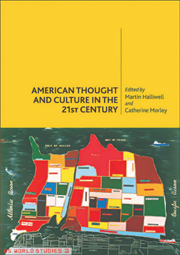Book contents
- Frontmatter
- Contents
- Acknowledgements
- Notes on the Contributors
- Introduction: The Next American Century?
- PART 1 POLITICS
- PART 2 SOCIETY
- PART 3 CULTURE
- 13 Contemporary American Culture
- 14 Cultural Pluralism and National Identity
- 15 Writing in the Wake of 9/11
- 16 American Ways of Seeing
- 17 Television and Digital Media
- 18 Animation and Digital Culture
- Bibliography
- Index
18 - Animation and Digital Culture
from PART 3 - CULTURE
Published online by Cambridge University Press: 05 August 2013
- Frontmatter
- Contents
- Acknowledgements
- Notes on the Contributors
- Introduction: The Next American Century?
- PART 1 POLITICS
- PART 2 SOCIETY
- PART 3 CULTURE
- 13 Contemporary American Culture
- 14 Cultural Pluralism and National Identity
- 15 Writing in the Wake of 9/11
- 16 American Ways of Seeing
- 17 Television and Digital Media
- 18 Animation and Digital Culture
- Bibliography
- Index
Summary
The digital revolution happened without marches, placards and conflict; it was not about the overthrow of monarchs and governments; it was played out by corporate culture in cahoots with scientists, engineers and technologists. There was no conspiracy. For some, clinging to the term ‘new media’ meant that there was a modicum of resistance. There was still ‘old media’ – print, television, cinema – but with each passing day, these too were absorbed within the digital realm. Some suggested that it was the end of history, the end of cinema, the end: a quiet apocalypse that ironically found a key touchstone in the tragic spectacle of 9/11 and the War on Terror played out by the Bush administration. The revolution will not be televised, but nowadays it will inevitably be digitised.
As the YouTube, MySpace and Second Life generation enjoys its apparently democratic presence on the Internet, and the economies of domestic acquisition of digital equipment and software applications change to facilitate back-bedroom studios, issues in production, exhibition, distribution and, crucially, representation have inevitably changed. Shilo McClean has noted that ‘this raises an extensive array of philosophical issues when what we view in images moves from recording to representational technologies, substituting idealised and stylised imagery for the indexical record’. Kay Hoffman qualifies this, though, by noting that ‘with digitisation we may have to adjust to a new magnitude of constructedness of the image, when it comes to how “reality” is presented to us in film and television, but the principle and the problem are as old as the cinema itself’.
- Type
- Chapter
- Information
- American Thought and Culture in the 21st Century , pp. 291 - 306Publisher: Edinburgh University PressPrint publication year: 2008



